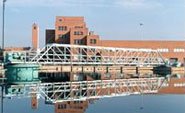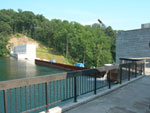

Baltimore uses surface water from rainfall and snowmelt as the source of its water. The City of Baltimore water supply system consists of three major sources: the Gunpowder Falls, North Branch Patapsco River and the Susquehanna River. Three reservoirs outside the city limits collect and store water.
Liberty Reservoir is located on the North Branch of the Patapsco River on the boundary between Baltimore and Carroll Counties. It collects water from a 163.4 square mile drainage area that includes eastern Carroll County and southwestern Baltimore County.
Liberty Dam was completed in 1954, has a spillway crest elevation of 420 feet above mean sea level (MSL), and impounds approximately 43 billion gallons of raw water with a surface area of approximately 3,900 acres.

The Liberty watershed is divided into seven subwatersheds: Beaver Run (14.11 sq. mi.), Bonds Run (5.83 sq. mi.), Liberty Reservoir (46.57 sq. mi.), Little Morgan Run (7.14 sq. mi.), Middle Run (6.14 sq. mi.), Morgan Run (28.06 sq. mi.), and North Branch (55.51 sq. mi.). Water from the reservoir flows by gravity through a 12.7-mile long, 10-foot diameter tunnel to the Ashburton Water Filtration Plant for treatment.
Loch Raven Reservoir is north of Baltimore City and its watershed occupies Northern Baltimore County and small parts of Western Harford County and Southern York County, Pennsylvania. The source of reservoir water is Gunpowder Falls.
 Loch Raven Dam was initially constructed in 1915 with a spillway elevation of 192 feet above MSL and raised to its current spillway crest elevation of 240 feet above MSL in 1923.
Loch Raven Dam was initially constructed in 1915 with a spillway elevation of 192 feet above MSL and raised to its current spillway crest elevation of 240 feet above MSL in 1923.
The reservoir capacity is approximately 23 billion gallons and the impounded area is roughly 2,400 acres. The Loch Raven Reservoir watershed is divided into eight subwatersheds: Beaver Dam Run (20.73 sq. mi.), Dulaney Valley Branch (3.24 sq. mi.), Gunpowder Falls I (24.56 sq. mi.), Gunpowder Falls II (1.77 sq. mi.), Little Falls (53.63 sq. mi.), Loch Raven Reservoir (59.31 sq. mi.), Piney Run (12.39 sq. mi.), and Western Run (47.67 sq. mi.).
Raw water from Loch Raven Reservoir travels through a 7.3-mile long, 12-foot diameter tunnel for treatment at the Montebello Filtration Plants in Baltimore.
Prettyboy Reservoir is in the northwest corner of Baltimore County and its 80 square mile watershed lies in northern Baltimore County and small portions of northeastern Carroll County and southern York County, Pennsylvania. Prettyboy Dam was completed in 1932, has a spillway crest elevation of 520 feet of MSL, impounds about 19 billion gallons of water, and covers about 1,500 acres.
The Prettyboy Watershed has been divided into four subwatersheds: Georges Run (15.85 sq. mi.), Graves Run (7.66 sq. mi.), Gunpowder Falls III (27.27 sq. mi.), and Prettyboy Reservoir (28.97 sq. mi.). Prettyboy Reservoir water is transferred to Loch Raven Reservoir via Gunpowder Falls rather than directly to Baltimore. The dam releases water as needed into the river channel, which flows into Loch Raven Reservoir.

Water from the Susquehanna River, approximately 11 miles north of Aberdeen near the Pennsylvania State line, is pumped via the Dear Creek Pumping Station to the Montebello Filtration Plants through the 38-mile long Susquehanna Conduit. This source is normally used during times of extreme drought when storage becomes depleted in the reservoirs. In 2002 the persistent rainfall deficit gave sufficient cause to tap this water source. It is anticipated that it will be used as a continuous raw water source in the near future.
The Susquehanna Supply has a present capacity of about 150 million gallons per day with a planned future capacity of 200 million gallons per day.
Anne Arundel County The City of Baltimore has an agreement to provide up to millions gallons per day of drinking water to residents of Anne Arundel County from the Second Distribution Zone. Water reaching Anne Arundel County residents is treated at the Ashburton Filtration Plant. The raw water supply comes from Liberty Reservoir.
Baltimore County The City of Baltimore provides drinking water to over 600,000 residents in Baltimore County. Major portions of the Liberty Reservioir and Loch Raven Reservoir watersheds are located in Baltimore County as well as several potable water storage tanks and pumping stations. Baltimore County is a major consumer of drinking water produced by the City of Baltimore. The 1994 average-day and maximum-day demands were 102 million gallons per day and 152 million gallons per day. These demands are projected to increase to 156 million gallons per day and 234 million gallons per day, respectively. Continued demand for additional drinking water along with tougher federal drinking water regulations will require additional capital expenditures by the City and County in the coming years.
Carroll County The City of Baltimore maintains two separate agreements with Carroll County.One allows the Freedom Sanitary District to withdrawal an average flow of 2.4 million gallons per day and a maximum flow of 3.0 million gallons per day of untreated water from Liberty Reservoir. The second agreement is with the Town of Westminster and recognizes the rigt of Westminster to take up to 2 MGD from tributaries of the Patapsco River. The North Branch of the Patapsco River is the main feeder stream to Liberty Reservoir.
Harford County Harford County's water system has 600 miles of water mains with 13 storage tanks holding more than 12 million gallons of water. They have three water treatment plants: one plant treats surface water from either the Loch Raven Reservoir or the Susquehanna River, another plant treats surface water from the Susquehanna River, and the third plant treats ground water from seven wells. In 2008, they provided 4.2 billion gallons of water to 110,000 consumers for an average of 12 million gallons each day. The county obtains 2.3 billion gallons of water from the Loch Raven Reservoir, 600 million gallons from the Susquehanna River, and 1.3 billion gallons of groundwater from wells tapping the Potomac Group Aquifer.
Howard County The City of Baltimore provides drinking water supplies to the eastern portion of Howard County .The raw water supply comes from Liberty Reservoir which is treated at the City’s Ashburton Water Filtration Plant.The County’s system is currently supplied through three connections to the City water system and one from the Washington Suburban Sanitation Commission.The three City/County connections are Gunn Road, Route 40, and Elkridge. Through these connections, the County can receive an average flow of 38.5 million gallons per day with a maximum flow of 68.1 million gallons per day.